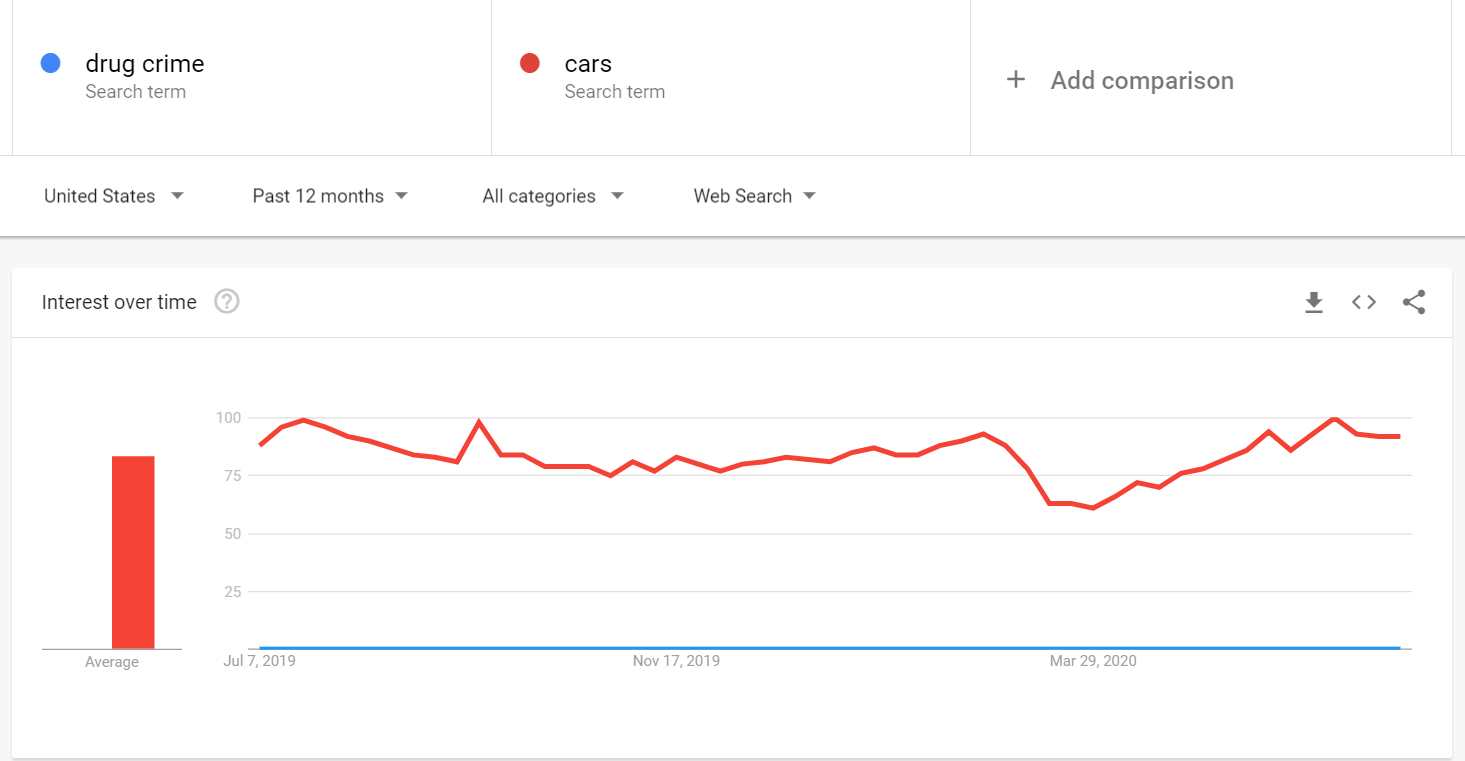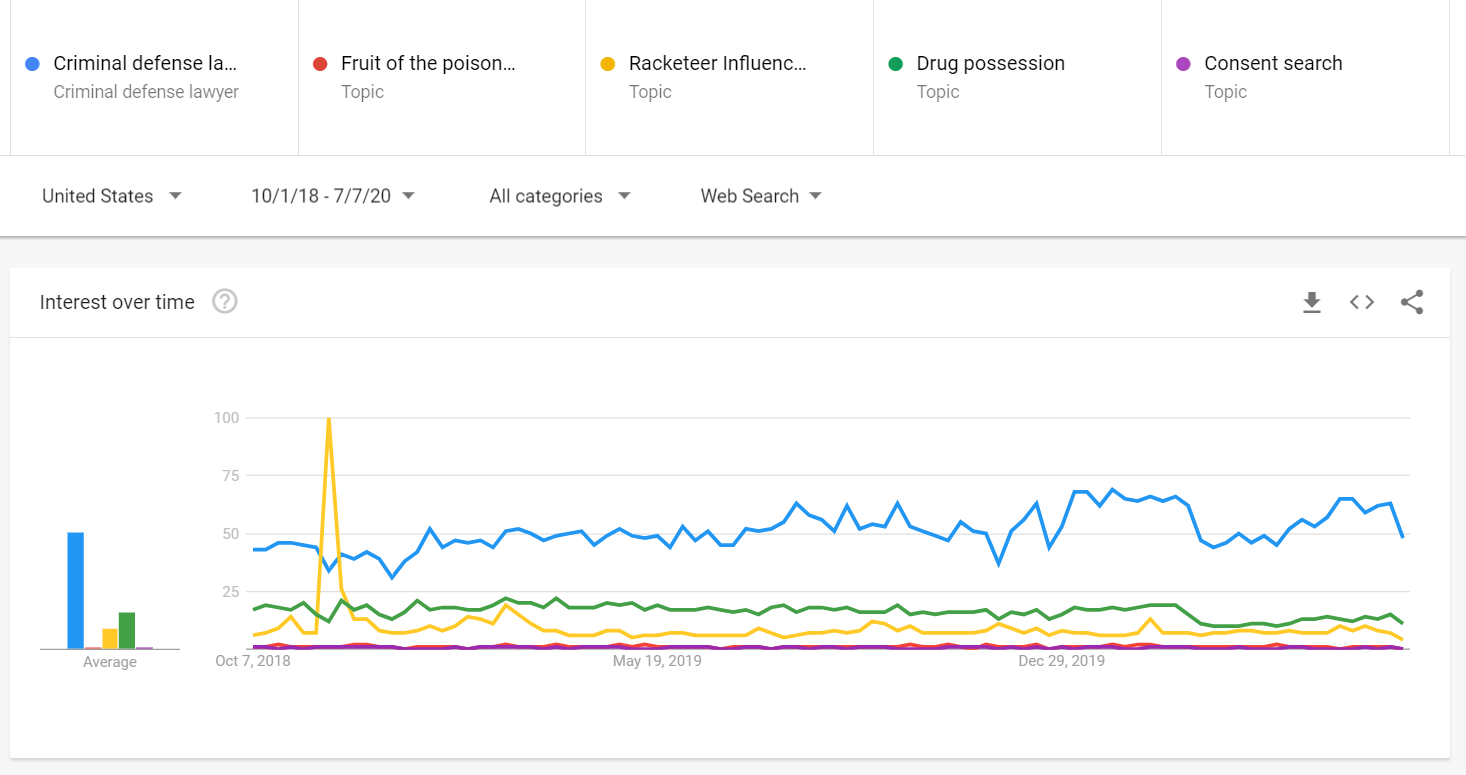[Update 7/7/2020: Recent “upgrades” to our content management system made it impossible to embed Google Trends data… but only when comparing multiple search terms. We have replaced these graphs with screenshots from Google Trends, which will not be interactive and will not update, until we find a more permanent solution.]
Online legal marketing is increasingly becoming a data-driven field. There are lots of numbers to crunch before knowing that a particular marketing venture—like a 3,000-word landing page on field sobriety tests—is going to be a solid investment for your law firm. Most of those numbers, unfortunately, are only accessible through programs run by marketing companies that are prohibitively expensive for law firms that are only interested in advertising their own business.
Google Trends is an exception. It provides most of that information for free. However, the emphasis is on the word “most,” and it comes with an important caveat: The format can mislead people who are not aware of the site’s limitations.
Once you understand Google Trends’ limitations, though, there are ways to play with the data to find the insight you’re looking for.
What is Google Trends?
Google Trends is an outlet that Google uses to showcase some of its data and let the world know what other people are searching for. It lets you see what keywords are hot, where they are hot, and when they were hot, in the past. It also lets you compare different keywords against each other to see which one is more popular.
Google Trends is Limited to Comparing Data
The value that Google Trends can provide has an important limitation, though: The information that it has only deals with comparing keywords, rather than providing an objective indication of a term’s popularity. On Google Trends, you will not find out that 683 people searched for “DUI-defense lawyer in Texas” in March, 2018. Instead, you will how often people made that query, compared to other months of the year.
Take the keyword phrase “drug crime” from Google Trends:
The graph only shows how searches for “drug crime” stack up against identical searches, done at other times. Note the vertical axis on the left—it goes from zero to 100, with 100 being the keyword’s most popular time period, and all other numbers being relative to it (50 being half of the peak). Therefore, every keyword that you analyze on Google Trends will hit 100 at some point, unless it’s so rarely used that there is not enough data to get off zero.
This is less than helpful, because in addition to needing to know whether the query is trending up or down, you need to know how popular it is, on an objective level, to decide whether to write a legal blog or landing page to cater to a given search query.
Solution: Set a Baseline for More Objective Data
Notably, one keyword’s 100 is not necessarily another keyword’s 100. Just take a look at how the search “drug crime” stacks up against the very popular search for “cars”:

“Drug crime” doesn’t even compete because “cars” is so popular.
You can use this feature to glean some more objective data about potential content pages by creating a baseline query in Google Trends and then using that baseline to compare a host of queries you are thinking of targeting.
Say you’re a criminal defense lawyer in Nebraska. You’ve got a long weekend coming up and want to add a page to your website to attract more clients, or you’ve just won a case, have some cash, and want to funnel it back into your firm’s marketing budget by paying a professional legal blogger to write the content while you sleep in after a long trial. There are a lot of pages that you can add, from consent searches to drug possession charges to an in-depth analysis of the fruit of the poisonous tree doctrine to RICO offenses.
Which one’s going to get the most return?
By comparing all of those potential topics against a baseline search query for a criminal defense lawyer in Google Trends, you can see that legal analyses of consent searches and fruit of the poisonous tree—while they would be fascinating to some people—are not going to net much traffic:

Meanwhile, searches for RICO offenses flew through the roof back in the middle of November, 2018 when a popular rapper was indicted on a RICO charge, and bumped upwards at the time of publication (February 11, 2019), as a result of recent action by the Mueller investigation. However, before getting caught up in the RICO excitement, it’s easy to see that, in the long term, searches related to drug possession are more common.
Note Your Competition Before Making a Commitment
Of course, chances are high that your competition is utilizing some of this same information, or may have fallen into high rankings for a targeted search with some strong content of their own. Checking out the strength of your competition for a given search query is essential before making the commitment to challenge the rankings. If you are committing to a 3,000-word page, but don’t know whether to write about RICO offenses or drug possession, finding out that there is an entire website dedicated to RICO defense work in your area, but there is no solid content on drug possession can make your decision easy.